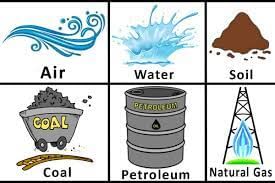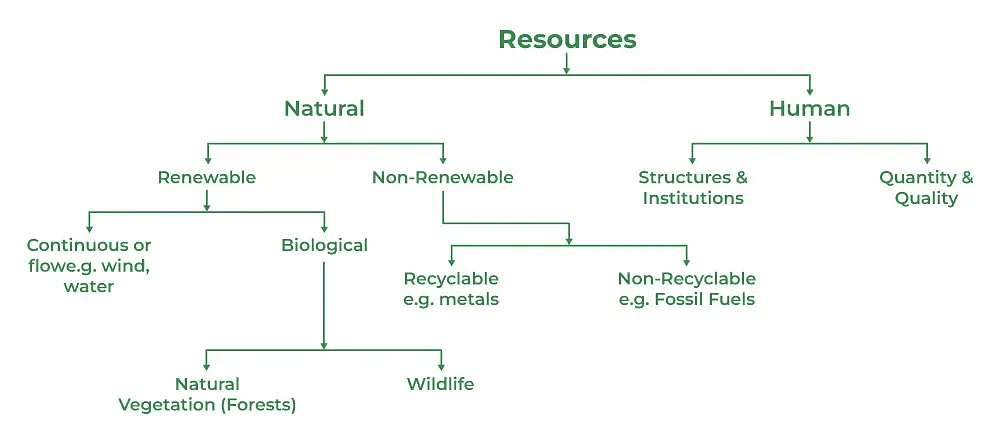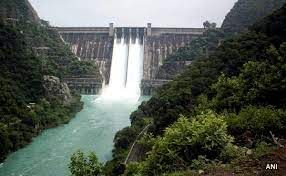Class 10 Geography Chapter 1 Question Answers - Resources and Development
Short Answer Type Questions
Q1: What is a Resource? Give two examples.
Ans: Everything available in our environment which can be used to satisfy our needs, provided, it is technologically accessible, economically feasible and culturally acceptable can be termed as a Resource. Examples are coal, water, air, minerals, etc.

Q2: What is the importance of natural resources? Why is it necessary to conserve them?
Ans: Resources are important for the development of any country. For example, fossil fuels are essential to generate energy, mineral resources are important for industrial development, etc.
Necessary to conserve resources because:
(i) Their irrational consumption and over-utilisation have led to socio-economic and environmental problems.
(ii) It takes millions of years for the formation of natural resources.
(iii) Natural resources are available in fixed quantity and they are non–renewable.
Q3: What are the ways to classify resources?
Ans: (i) On the basis of origin – biotic and abiotic.
(ii) On the basis of exhaustibility – renewable and non-renewable.
(iii) On the basis of ownership-individual, community, national and international.
(iv) On the basis of the state of development- potential, developed and stock.

Q4: What is the role of humans in resource development? [CBSE 2014]
Or
Explain the role of humans in resource development. [CBSE Sept. 2010, 2011],
Ans: (i) Resources are a function of human activities.
(ii) Human beings interact with nature through technology and create institutions to accelerate their economic development.
(iii) Human beings transfer materials available in our environment into resources and use them.
(iv) For example, a river is a natural endowment and it becomes a resource when its water is used for irrigation or power production.
Q5: What are renewable resources? Give two examples.
Ans: The resources which can be renewed or reproduced by physical, chemical or mechanical processes are known as renewable or replenishable resources. For example, solar and wind energy, water, forests and wildlife, etc. The renewable resource may further be divided into continuous or flow.
Q6: What are non-renewable resources? Give two examples.
Ans: These occur over a very long geological time. These resources take millions of years in their form. Some of resources like metals are recyclable and some like fossil fuels cannot be recycled and get exhausted with their use. For example, coal, bauxite.
Q7: What are individual resources? Give two examples.
Ans: Resources which are owned by private individuals are known as individual resources. Plots, fields, house, car, book, etc. are some examples of individual resources.
Q8: What are community-owned resources? Give two examples.
Ans: The resources which are accessible to all the members of the community are known as community resources. Village ponds, public parks, playgrounds, etc. are some examples of community resources.
Q9: What are national resources? Give two examples.
Ans: All the resources which are under the control of state or union government are known as national resources. All the resources within political boundaries are national resources because the government has the power to acquire even private property. For example, the Indian railway, and Bhakra dam.
 Bhakra damQ10: What are potential resources? Give two examples.
Bhakra damQ10: What are potential resources? Give two examples.
Ans: Resources which are found in a region, but have not been utilised due to lack of capital or other reasons. For example, the western parts of India particularly Rajasthan and Gujarat have enormous potential for the development of wind and solar energy, but so far these have not been developed properly.
Long Answer Type Questions
Q11: What is resource planning? Mention the steps which are involved in resource planning. [CBSE 2009 (F); Sept. 2010, 14]
Or
Explain the three steps involved in resource planning in India. [CBSE Sept. 20W]
Or
What are the three stages of resource planning in India?
Ans: “Resource planning is a technique or skill of proper or judicious use of resources. ”
Resource planning is a complex process which involves :
(i) Identification and inventory of resources across the regions of the country. This involves surveying, mapping, qualitative and quantitative estimation and measurement of the resources.
(ii) Evolving a planning structure endowed with appropriate technology, skill and institutional set up for implementing resource development plans
(iii) Matching the resource development plans with overall national development plans.
Q12: Explain the classification of resources on the basis of exhaustibility. [CBSE 2009 (D), Sept. 2010, 2011]
Ans: (i) Renewable resources: “Renewable resources are the natural resources which can be used again and again or can be reproduced by physical, mechanical and chemical processes.” Solar energy, air, water and soil are some of the renewable resources of energy.
(ii) Non-renewable resources: “Non-renewable resources are the natural resources that cannot be replaced at all or within a reasonable time.” Fossil fuels such as oil, gas and coal are examples of non renewable resources. These resources are accumulated over millions of years. They are considered to be non-renewable resources because once they are used up, they are gone forever.
Q13: Explain the classification of resources on the basis of ownership. [CBSE 2009 (O), 2014]
Or
Explain what is meant by national resources and individual resources. [CBSE Sept. 2010, 2014]
Ans: (a) Individual Resources: Resources which are owned by private individuals are known as individual resources. Plots, fields, houses, cars, books, etc., are some examples of individual resources.
(b) Community Owned Resources: The resources which are accessible .to all the members of the community are known as community resources. Village ponds, public parks, playgrounds, etc., are some examples of community resources.
(c) National Resources: All the resources which are under the control of state or union government are known as national resources. All the resources within political boundaries are national resources because the government has the power to acquire even the private properties.
(d) International Resources: These resources are owned and regulated by international institutions. The oceanic resources beyond 200 km of the Exclusive Economic Zone belong to the open ocean, and no individual country can utilise these without the concurrence of international institutions. India has got the right to mine manganese nodules from the bed of the Indian Ocean from that area which lies beyond the Exclusive Economic Zone.
Q14: Explain the classification of resources on the basis of the state of development. [CBSE 2008]
Or
Distinguish between stock resources and reserve resources. [CBSE Sept. 2010,12]
Ans: (i) Potential Resources: Resources which are found in a region, but have not been utilised due to lack of capital or other reasons. For example: the western parts of India, particularly Rajasthan and Gujarat have enormous potential for the development of wind and solar energy, but so far, these have not been developed properly.
(ii) Developed Resources : These are resources which have been surveyed and their quality and quantity have been determined for utilisation. The development of resources depends on technology and the level of their feasibility. For example, India has a cumulative total of about 2,47,847 million tonnes of coal resources.
(iii) Stock : These are the materials in the environment which have the potential to satisfy the human needs but cannot be used as human beings do not have the appropriate technology to convert them into usable form. For example, water (H20) is a compound of two inflammable gases, i.e., hydrogen and oxygen, but human beings do not have the required technology to use them as a source of energy.
(iv) Reserves : These are the subset of the stock, which can be put into use with the existing technology, but their uses have been postponed keeping in mind the needs of the future generations. For example, India has sufficient amount of forests to fulfil the needs of the present generation, but they are being protected for the future generations.
Q15: How is land a natural resource of utmost importance ? Explain with four facts. [CBSE 2008 (O), 2012, 2013]
Or
“Land is a natural resource of utmost importance.” Elaborate the statement with the help of suitable examples highlighting the value of land resource. [CBSE 2013]
Ans: Land is an important natural resource, because :
(i) All economic activities are performed on land.
(ii) It supports natural vegetation and wildlife.
(iii) Most of the minerals are formed in land.
(iv) It is used for transport and communication system.
Q16: Which is the most widely spread and important soil of India? State any six characteristics of this type of soil. [CBSE 2008 (F), Sept. 2010]
Or
Mention any four characteristics of alluvial soils.
Or
How are alluvial soils formed? How is Bangar different from Khadar? [CBSE 2012]
Ans: Characteristics of the Alluvial soil are :
(i) Alluvial soils are transported soils. Most of the soils are derived from the sediments deposited by rivers as in the Indo-Gangetic plain. Thus, the parent material of these soils is of transported origin.
(ii) These soils consist of varying proportion of sand, silt and clay. In the upper course of the river, the soil is coarse. In the middle course, it is medium, and fine grained in the lower course.
(iii) Apart from the size of their grains or particles, soils are described according to their age as well. They are old alluvium and new alluvium. Locally, the old alluvium is called ‘Bhangar’ and the new alluvium is called ‘Khadar’.
(iv) The old alluvium often contains ‘kankar, nodules, with calcium carbonates in the sub-soil. The new alluvium is more fertile than the old alluvium.
 Major Soil Types
Major Soil Types
Q17: Which soil is called ‘regur soil? Mention any four characteristics of this type of soil. [CBSE 2009 (F), Sept. 2010, 2012, 2013]
Ans:
(i) These have been formed due to withering of lava.
(ii) The black soils are made of extremely fine materials, i.e., clayey materials.
(iii)These soils are rich in soil nutrients such as calcium carbonate, magnesium carbonate, potash and lime.
(iv)These soils are generally poor in phosphoric content.
(v)The soil is well known for its capacity to hold moisture.
Q18: How is red soil formed? Mention its three characteristics. [CBSE Sept. 2010]
Or
How does red soil develop? What makes it look red and yellow? [CBSE 2014]
Ans: Formation : Most of the red soils have come into existence due to weathering of ancient crystalline igneous rocks. Characteristics/Features :
(i) Soils are loamy in deep depressions and in uplands. They consist of loose gravels and highly coarse materials.
(ii) The colour of these soils is generally red, often grading into brown, chocolate or yellow. The red colour is due to wide diffusion rather than high percentage of iron content. It looks yellow when it occurs in a hydrated form.
(iii) Soils are deficient in phosphoric acid, organic matter and nitrogenous materials but are fairly rich in potash. But crops are cultivated with the use of fertilizers.
Q19: Which geographical factors are responsible for the evolution of black soil? Why is it considered the most suitable for growing cotton? [CBSE 2012, 2013]
Ans: (1) Climatic conditions like temperature, rainfall etc. along with present rock material are important factors for making of black soil. The parent rock is volcanic rock.
(2) It is ideal for growing cotton because:
(i)It has capacity to hold moisture.
(ii)They are rich in calcium carbonate, magnesium, potash and lime.
(iii)This soil is also known as black cotton soil,
(iv) They develop deep cracks during hot weather, which help in the proper aeration of the soil.
Q20: How is mountain soil (forest soil) formed? Mention any four characteristics of forest soil. .
Ans: Formation: The soils are formed due to mechanical weathering caused by snow, rain, temperature variation, etc. Characteristics/Features:
(i) These soils are heterogeneous in nature, and their character changes with mountainous environment and altitude.
(ii) The soils are very rich in humus, but are deficient in potash, phosphorus and lime.
(iii) The soils are especially suitable for plantation of tea, coffee, spices and tropical fruits.
(iv) The soil is loamy and silty in valley sides and coarse grained in the upper slopes. It is acidic with low humus content in the snow covered areas. It is fertile in the lower parts of the valleys.
|
666 docs
|
FAQs on Class 10 Geography Chapter 1 Question Answers - Resources and Development
| 1. What are natural resources and why are they important for development? |  |
| 2. How can we classify resources based on their origin? |  |
| 3. What is sustainable development and why is it important? |  |
| 4. What are the challenges faced in resource planning? |  |
| 5. How can we promote sustainable development and responsible resource use? |  |






















